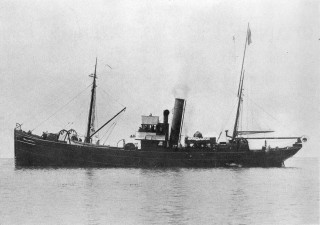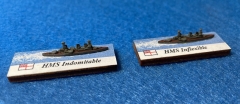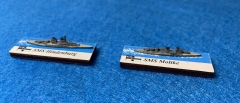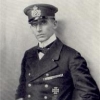Battlecruiser Rejoinder
13 December 1917
Following the play of the December 1917 North Sea convoy battles, there was some interest by at least one member of the group in playing out a clash between Admiral Leveson’s 2nd Battlecruiser Squadron detachment (Force W) and Admiral Boedicker’s 1st Scouting Group detachment covering force (Flot 104). With that in mind, a subset of the group reconvened a few weeks back to have a go. We used the same controller/umpire arrangement as earlier, which not only worked great, but they wrote the scenario such that it was almost believable.
The only stipulation by the controller was that the clash had to originate from the positions and chronology as written and played in the original scenario. With that in mind, he had each side secretly plot their anticipated unit movements following the clash that occurred in the early morning hours of 13 December. These they sent to him using map-sheets he provided.
I had a call with the controller a few days beforehand just to go over everything. I not only wanted to be sure that I had all of the bits required to host, but also to get some assurance that this wasn’t going to degenerate into some 4-6 hour exercise in futility similar to two blind boxers stumbling around the ring, never to lay a glove on each other. Picking it up on the operational map seemed to offer that possibility while being a lot of extra work; I suggested we just drop the BCs and DDs on the table and let folks slug it out, but he said that was a bad idea for a number of reasons. He’s a lot smarter than me, so I trusted him.
Before jumping off, we had a long talk about Rear Admiral Arthur Leveson, the key figure in this whole thing. At this time, Leveson was not only commander of the 2nd Battlecruiser Squadron, but he’d concurrently been appointed the Rear Admiral Commanding Australian Fleet. It would seem he had a lot more to lose than gain by engaging in such an aggressive/reckless pursuit this late in the war. His career had been somewhat uneven, especially during Fisher’s tenure as First Sea Lord, but he’d gained his feet under Jellicoe, serving as second-in-command of the 2nd Battle Squadron at Jutland where he’d received mention in dispatches. But now Jellicoe was gone, replaced by Beatty, so maybe Leveson would have seen this as an opportunity to once again put down his marker. Hard to say, but we both agreed he was going to need just a wee bit of help with this.
Day of Battle
His Majesty’s Trawler William Biggs drew in her booms and stowed her gear, pushing off from the minefields early-morning, 13 December 1917. She and two other trawlers had been sent to sweep a channel some 30 nautical miles northwest of Terschelling, and after five days they’d cleared about four linear miles and destroyed nearly 90 mines. Their efforts had not gone unobserved, however, and German destroyers had begun patrolling the area south of the trawlers in a somewhat tentative effort to drive off the British minesweepers. With the German patrols drawing ever closer, they pulled out, Biggs being the last to leave; she would steam north for two hours before turning northwest for an eventual date with the depot ship HMS Ambrose off Grimsby.
One of the first of the new Strath-class Admiralty trawlers, Lt. Arthur C. Platt had been given command of Biggs upon her commissioning back in August. She was a product of the Russell yard at Aberdeen, and at 429 tons, she seemed a sturdy enough ship. She’d been purpose built as a minesweeper, carrying all of the latest mechanical gear while lightly armed with a single 76/40 12pdr (3-inch) QF Mk II up on her forecastle. She also had a locker with a dozen Lee-Enfields, and there was a single Lewis gun which had surreptitiously come into Platt’s possession, now stowed in its wooden box in that same locker. She was dead slow as designed, a single vertical triple-expansion engine and boiler that could push her along at ten knots, maybe twelve with a following sea. She was certainly no match for a German destroyer.

A Strath-class Admiralty trawler.
The weather was generally good as Biggs churned north, but by 0930 the wind had begun to pick up out of the northeast and the sea was soon dotted with whitecaps. An hour later, temps had dropped to near-freezing and they were battling gale-force winds with great walls of ice-cold rain washing over them, low ceiling and visibility down to just a few thousand yards. Rolling in the swells, it was everything one could do to avoid tumbling over the side.
Two hours passed with no let-up in the conditions; if anything, visibility got worse as the wind direction shifted to the east. Pratt went below for a few minutes to look at a problem with one of the pumps, soon put to right by his Chief. On his way back to the wheelhouse, he stopped momentarily to grab a cuppa from the galley. Up the ladder and down the deck, he’d no sooner entered the wheelhouse when he heard the helmsman call upon the Almighty; there, scarcely three thousand yards off his port bow, a great warship had emerged from a squall to cross the churning sea in front of them. Then, in a matter of just two or three minutes, she disappeared into another wall of rain and cloud off the starboard bow, soon followed by a second ship, this at some further distance. In the driving rain Pratt was unable to identify them, but they were big, and the German naval ensigns fluttering from their sterns were unmistakable.
Like phantoms, they were gone as quickly as they had appeared. Pratt held his breath waiting for the rest of the German Navy to cross his bow, possibly to run down his trawler in these abysmal conditions, but no other ship was seen. Five minutes passed, then ten, before he ordered a message sent with all of the particulars of numbers, types, time, speeds, and headings (as best he could determine). Hearing no response, a second message was hammered out a few minutes later, a repeat of the first, this soon followed by a brief acknowledgement. Staring ahead, Pratt sipped his now cold tea as HMT William Biggs pushed on into the gale; he, like every man in the wheelhouse, felt like he could breathe again.
----------------------
Intel sometimes moves like a glacier, languishing in some junior officer’s hands before being relayed, but given the dust-up off the Humber overnight, Pratt’s report moved up the chain at uncharacteristic speed. The information passed through a number of stations before reaching the Admiralty. There it is was reviewed and evaluated, a quick search for any corroboration (there was none), then relayed to Leveson’s Force W, now just seventy miles northeast of Pratt’s position on a southeasterly heading.
The fact that Leveson was in such an advanced position was entirely the product of his own initiative (or madness, depending upon one’s viewpoint). When the reports came in of the attack on Convoy 5 earlier that morning, it had taken him nearly three hours to get to sea, but once in open water, he’d wasted little time triangulating his position and a presumed course of interception using his best-guess of Von Reuter’s escape route. He had no reason to suspect that Pratt’s sighting was anything other than Von Reuter’s cruisers (although it does seem the German would have made remarkable progress to have reached such an advanced position so quickly). He tweaked his course again based on a slightly revised estimated heading of the enemy, ordering his brace of battlecruisers ahead-full (just 15 knots in the deteriorating weather). His three destroyers were soon left behind, unable to keep up in the heavy seas.

For his part, Boedicker remained oblivious to these developments. The fact that he’d been spotted by a British trawler was unknown to him; no one had observed Biggs bobbing in the rough seas, or at least no one had reported it, nor had anyone overheard the subsequent radio transmission revealing their position and other specifics. His primary concern was Moltke, having suffered some minor flooding in a compartment behind the forward magazine due to a ventilator torn away by water crashing over the port side. Gygas was forced to keep the speed down until temporary repairs could be made, thereby not adding to the amount of seawater washing around the lower decks.
As the great Yogi Berra is reported to have once said, “It sure gets late early around here”, it is a notion that Leveson is keenly aware. As the clock rolls past 1500, he knows he hasn’t much more than ninety minutes of light remaining. His plot of the enemy’s presumed course has Force W not on that position until 1930, more than two hours after nightfall. The only good news is the dreadful weather conditions have subsided somewhat, allowing Hawksley and Loring to raise their respective battlecruisers’ speed to 21 knots while maintaining Leveson’s heading. An hour later, conditions are much improved, the seas now Force 4, the skies clearing. Leveson orders speed increased again, this to 23 knots. As the sun sinks over the horizon, there is precious little moonlight to replace it.
As noted in the FAI rulebook, when the balloon went up in 1914, the Royal Navy doctrine for night combat was along the lines of “AVOID AT ALL COST”. They were largely ill equipped and certainly untrained for it, a circumstance that began to change following the near-run thing that was Jutland. The German Navy, on the other hand, had trained and equipped for night combat “opportunities”. They had a few tools in their arsenal that gave them somewhat of an advantage, one being the development and supply of star shells. Their biggest advantage, however, was the training they’d received and the mindset that came with it.
While the south end of the North Sea is fairly large, it is also somewhat funnel-shaped at its eastern and western corners. Positioning one’s self at the mouth of the funnel raises the odds of interception considerably. Studying the charts, Leveson still thought it all a terrific longshot. He had received no additional reports of sightings, either by surface units or routine patrols out of RNAS Atwick (all grounded due to the storm). This gave him no way to validate or correct his presumptions. Without any further information, he was left to rely on his first estimate of the enemy’s speed and heading made many hours earlier. A slower German speed and he’ll overshoot the intercept, a faster speed and he’ll pass undetected in their wake. He decided he would continue to his original calculated point of intercept and, if no enemy contact, turn due east to continue along the enemy’s presumed course. He will, however, have only about fifty miles of open sea for maneuver before the charts have him reaching the edge of the German mine-belt. By 1730, the skies had cleared, the wind speed had dropped considerably, and the sliver of light that is the new moon rises in the east.
At 1936, the controller hands out plot sheets to each commander, noting the current position, heading, and speed of their respective “unit”. Working with the RN player, the controller pencils in Leveson’s planned southeastern course and eastward turn on the RN player’s sheet. The German’s course and relative positions of both Von Reuter and Boedicker are similarly noted on the German’s sheet. The controller has all of it noted on his master and, with no variance from each unit’s planned course allowed, the acquisition drill will be relatively straightforward. There are no dummy units provided, so this will be a straight up dark acquisition drill under an umpire’s direction. For both commanders, the provision of plot sheets is the first indication that a general proximity has been reached.
Leveson had doubled the watch at dusk and ordered speed reduced to 20 knots. An exchange of messages with Sanford had his destroyers some 35 nautical miles aft, putting them more than four hours from rejoining the battlecruisers. The 1936 review of the tactical plot with the controller had the BCs continuing on their present southeasterly heading for roughly 40 minutes, then the planned turn east.
At 1954, a report comes in from the Inflexible’s director topside, a ship, possibly two, spotted broad on the starboard bow at an approximate range of 5200 yards (a d12 roll of “1” on the RN dark acquisition table). The target is determined to be on an eastward heading at a speed of approximately 15 knots. Leveson orders both Hawksley and Loring to immediately open on the lead ship, well within their broadside arc. No hits are observed.
Boedicker, Gygas, Eberius, and their respective watch details are caught totally unawares. Gygas is below deck, inspecting the clean-up of Moltke’s flooding from earlier in the day. Boedicker is in his quarters, writing the day’s notes in his journal. Eberius is on Hindenburg’s bridge preparing for their approach to the Jade, now just five or six hours away. The sound of large-caliber gunfire and the resulting shell splashes off Moltke’s port beam are a good first indication that all is not right. A query as to the source of the gunfire brings no reports.

Within minutes, both Boedicker and Gygas are back on the bridge, but the source of the gunfire remains unknown (a d12 roll of “11” on the HSF dark acquisition table, shifted left two columns for gun-flashes). Leveson maintains his heading and speed, closing the range to 4400 yards. At 1957, the next salvo sees Inflexible land a 12-inch hit on Moltke at the base of her mainmast, destroying a number of her 3.4-inch mounts while obliterating her searchlight position.
Boedicker finally gets a sighting report on the British battlecruisers at 2000; there are two ships rapidly closing on his port beam. He orders Eberius’ Hindenburg to open on the lead ship, the range being roughly 3900 yards; no hits are observed. Inflexible and Indomitable return fire, their target the lightly damaged Moltke; similarly, no hits are observed.
At this point, Leveson has learned two things; first, the quality of BC targeting and gunfire has not improved from that experienced early in the war, and second, he’s tangling with German capitals far larger than Von Reuter’s light cruisers. At 2003, he tells Hawksley to bring the column around in a sharp turn to the southwest after the next exchange, attempting to cross behind the German column.
Leveson has the initiative, and sees Indomitable land a 12-inch round on Moltke, easily penetrating and disabling her aft Y-turret at just 3100 yards. Moltke opens on Inflexible, scoring no hits, but Hindenburg hits her twice, disabling and flooding her starboard fixed torpedo positions, then a hit that penetrates her armor belt, flooding an additional hull-box. Inflexible is able to maintain her 20 knot speed, even as she begins her turn to the southwest.
Leveson’s maneuver will cost him; his BCs, unable to return fire while executing their sharp turn, will see Inflexible absorb a beating. Moltke lands a pair of 11-inch, one disabling a 4-inch mount adjacent to her third funnel, the second penetrating her hull, flooding a number of compartments while reducing her speed to a 16-knot maximum. Hindenburg does more damage; a disabling hit on A-turret that sends a shower of splinters in all directions, another hit that results in a 4-inch secondary mount destroyed, and a third that takes out the majority of her 3-inch, and knocking down her searchlights.
Hawksley surveys the damage, realizing it’s not as bad as it likely could have been. Within a few minutes he receives a report that the hit on A-turret was not mortal and that it has returned to action. Flooding has Inflexible’s bow and speed down, but the damage parties report it’s under control, for now.
Such optimism is extinguished in the next few minutes. With the range just 2500 yards, the Germans score another pair of hits on Inflexible, one at the waterline just beneath her bridge, the second an 11-inch round that knocks her aft turret offline. She does manage a hit on Moltke at the waterline, and Indomitable disables a number of the German’s 5.9-inch mounts.
At 2012, Hawksley goes to Leveson to tell him that they are now struggling to manage Inflexible’s flooding (although they have been able to quickly return her aft main battery to service). Listing slightly, her bow nearly awash, and speed down to an 11-knot maximum, she fails her morale check. Leveson orders Hawksley to disengage and withdraw, signaling Indomitable to provide cover.
Over on the other side, Boedicker has concerns that he’s been run down by the vanguard of some sizable portion of the Grand Fleet. Without a sense of what damage has been inflicted on the enemy, and Moltke having suffered a number of hits topside and at least one hit at the waterline, his inclination is to withdraw to the east as quickly as possible. Advised that Moltke’s top speed is now 24 knots, he tells Gygas to raise her speed to 20 knots for withdrawal to the southeast.
Inflexible and Indomitable complete their turn to the northwest, holding their fire. Boedicker orders Hindenburg to shift fire to Indomitable, but before doing so (or attempting to do so), she lands another 11-inch on Inflexible, further aggravating her already serious flooding and reducing her speed to just eight knots (this hit was disputed on a question of LoS, settled by die roll).
Leveson orders cease fire, hoping to slip away in the darkness. With the range having lengthened to nearly 5000 yards, Hindenburg is able to spot Indomitable, firing a final time but missing. At 2015, the intervening distance now more than 7200 yards, the Germans lose contact as Leveson moves beyond visibility.
Aftermath
It takes nearly two days for Inflexible to limp back to the Orkneys; her war is over. Indomitable will serve out the balance with Australia and New Zealand in the 2nd Battlecruiser Squadron, disbanded shortly after the war.
Leveson would continue command of 2nd BCS until promoted Vice-Admiral in Command, 5th Battle Squadron, in October 1918. In 1922, he was given command of the China Station, continuing in that role until September 1924. His career was unaffected by the near-catastrophic action of 13 December 1917.
Boedicker was promoted to Vice-Admiral in January 1918, but he, like much of the HSF, saw little action for the remainder of the war. In the final month, he was largely caught up in the efforts to subdue the mutinous behavior of broad swaths of the Navy’s enlisted men. He went on to an administrative post immediately following the HSF’s surrender, retiring in March 1919, a few months prior to the scuttling of the fleet.
This was our first real effort of any consequence at gaming night combat in WWI, and there were a few stops and starts along the way as we tried to feel our way through the accelerated turn sequences. The convergence of the two units in early evening just worked out based on the planning of both sides operationally. It might have happened a bit earlier, much later, or not at all. There’d been some thought that a night engagement might level the “field” a bit, but that proved wrong for a number of reasons. We definitely tilted the early going toward Leveson, but the d20s just proved too much to overcome. This, combined with some good German shooting, made for a quick engagement (over in just 82 scale minutes). The one rule worth a revisit is the shifting target rule, something that led to quite a bit of consternation and debate. Also, it seemed star shells were of little effective use at such close range, so they were not employed.
The AAR was compiled from a couple batches of notes. It’s tough to write these without it devolving into a running blow-by-blow accounting, and for that reason they can be tough to read. Much of the context seems to get lost. There are a lot of good points and banter along the way, but all or most of that gets left out; unfortunately, that part’s the most fun.
One last thing - this could have easily been played in 1/2400 on a large table as the ranges are extremely tight. Hadn't really thought about that while planning.
Anyway, for what it’s worth, battlecruisers at night is in the books.














